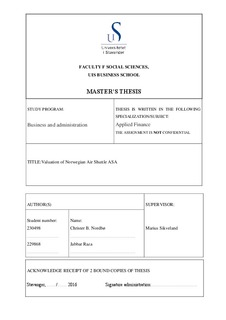| dc.contributor.advisor | Sikveland, Marius | |
| dc.contributor.author | Nordbø, Christer | |
| dc.contributor.author | Raza, Jabbar | |
| dc.date.accessioned | 2016-08-25T07:59:45Z | |
| dc.date.available | 2016-08-25T07:59:45Z | |
| dc.date.issued | 2016-06-15 | |
| dc.identifier.uri | http://hdl.handle.net/11250/2401559 | |
| dc.description | Master's thesis in Finance | nb_NO |
| dc.description.abstract | The purpose of this thesis is to do a valuation on Norwegian Air Shuttle ASA, and based upon this objective we have formulated the following problem statement: “What is the fair value of Norwegian Air Shuttle ASA as per 31.03.2016?” The purpose of this valuation is to evaluate if the stock price is either over or under priced. Based on the findings in this thesis, we estimated the stock price of Norwegian Air Shuttle ASA to be NOK 283,1. On 31.03.2016 the stock price of Norwegian Air Shuttle ASA was NOK 311,5 and therefore our claim is that the stock is overvalued. Our recommendation is then to sell the stock.
To answer the problem statement, we will do a fundamental valuation of Norwegian Air Shuttle ASA. First we did a strategic analysis, consisting one external analysis and one internal analysis. The external analysis consisted of a Pestle analysis and Porter Five Forces framework. This gave us the foundation for predicting future development and environment of the company. From the external analysis we found that the European market is driven by low margins and fierce competition. For the internal analysis we did a VRIO-analysis evaluating the internal resources. We found that the most valuable resources NAS had was their CEO Bjørn Kjos and their strong brand name.
The financial analysis consisted of a ROIC-analysis based upon the DuPont-Model. This analysis gave us the historical profitability and cost structure of the company. From these analyses we will use the key drivers found and build our forecasted statements based on these key drivers. From this analysis we found that NAS operates with a lower operating margin that Ryanair and easyJet. This is due to parts of NAS following Norwegian labour laws.
Using the information found in the strategic and financial analysis, we estimated the future income statement, balance sheet, and the free cash flows to the firm. The paper also includes the calculations of the WACC with a value of 5,53%. Based upon the findings in this paper we calculated the value per share with the FCFF method. We also tested our findings with a sensitivity analysis to find what factors will have the biggest effect on the estimated value per share. The sensitivity-analysis showed us that our model is highly sensitive to the fuel cost and the currency combined due to high volatility and sensitivity towards the cost of debt. The sensitivity towards the cost of debt is driven by NAS having a high debt to equity ratio. | nb_NO |
| dc.language.iso | eng | nb_NO |
| dc.publisher | University of Stavanger, Norway | nb_NO |
| dc.relation.ispartofseries | Masteroppgave/UIS-SV-HH/2016; | |
| dc.subject | økonomi | nb_NO |
| dc.subject | administrasjon | nb_NO |
| dc.subject | Norwegian Air Shuttle | nb_NO |
| dc.subject | valuation | nb_NO |
| dc.subject | finans | nb_NO |
| dc.subject | finance | nb_NO |
| dc.subject | verdivurdering | nb_NO |
| dc.title | Valuation of Norwegian Air Shuttle ASA | nb_NO |
| dc.type | Master thesis | nb_NO |
| dc.subject.nsi | VDP::Social science: 200::Economics: 210::Economics: 212 | nb_NO |
